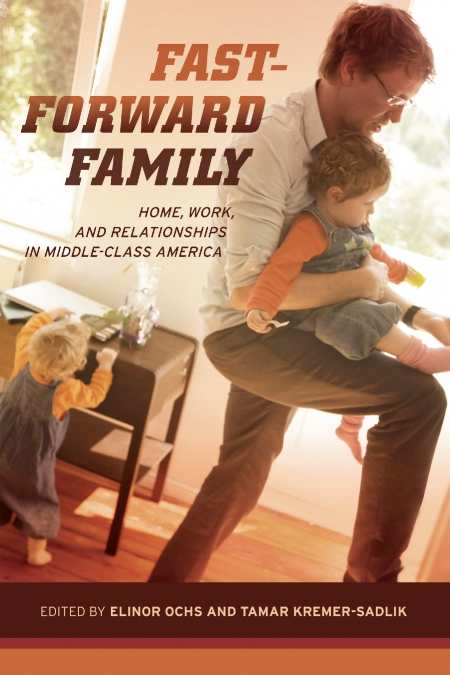Fast-Forward Family
Home, Work, and Relationships in Middle-Class America
In the 1930s, General Electric and an architectural magazine sponsored “The House for Modern Living” contest, inviting architects to design a house for “Mr. and Mrs. Bliss,” an imaginary couple with two children. The organizers described Mrs. Bliss as a housewife who “does her own housework for two good reasons: first, financial circumstances preclude an all-time maid; second, she actually enjoys the work.”
People who found pleasure in housework were probably rare then and continue to be uncommon now. More representative is a mother featured in Fast-Forward Family: Home, Work, and Relationships in Middle-Class America, who, as she folds laundry on a Saturday morning, talks on the phone to schedule a play date for her son; distracted by her year-old daughter’s cries, she picks her up and walks to the kitchen to cook a meal. “Personally, I don’t have a life,” she says. Her “middle-class dual-earner” family is one of thirty-two from the greater Los Angeles area that allowed a team of anthropologists, education specialists, linguists, psychologists, and sociologists to document their lives through video recording, photographs, and interviews from 2002 to 2005 and to summarize their research in this book, which is edited by Elinor Ochs and Tamar Kremer-Sadlik, social scientists at the University of California, Los Angeles.
Women are not the only ones feeling overwhelmed. A father of two boys complains about the stream of demands he faces at home; “there’s basically very little respite for me,” he points out. Echoing the findings of Arlie Russell Hochschild, a sociologist who, in a 1997 study described a reversal of the work-home relationship for workers in a large American company, the father says: “So I think my house kind of represents … work. And my workplace kind of represents rest in a certain way.”
Part of the stress arises from the labor required for cleaning, organizing, and storing the “mountains of things” that families own. In one house, the researchers find more than 2,000 “visible possessions” in three rooms. In the Depression-era competition, the winning entry incorporated thirty-two electrical appliances, all made by General Electric. Some of the modern Los Angeles families are better-provisioned, owning not one but two refrigerators, the second one often placed in the garage, which suffers an “identity crisis” because the family car has now been pushed out into the street.
Architects, interior designers, and vendors of furniture will enjoy learning about the real-life use of private spaces and objects unveiled in Fast-Forward Family. Other readers are likely to reduce the clutter in their lives if they follow the authors’ excellent advice to stop during shopping trips to reflect on the “exertion and hassle” that their purchases will demand when installed at home.
Reviewed by
Karunesh Tuli
Disclosure: This article is not an endorsement, but a review. The publisher of this book provided free copies of the book to have their book reviewed by a professional reviewer. No fee was paid by the publisher for this review. Foreword Reviews only recommends books that we love. Foreword Magazine, Inc. is disclosing this in accordance with the Federal Trade Commission’s 16 CFR, Part 255.

